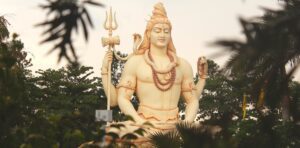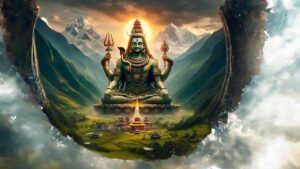How Many Hindu Gods Are There?
When we think of Hinduism, one of the first things that come to mind is the vast array of gods and goddesses. From Ganesha, the elephant-headed deity, to Hanuman, the monkey god, and Shiva, with a snake around his neck, Hinduism seems to have an overwhelming number of deities. This can often seem confusing and even unbelievable to those unfamiliar with the tradition. However, this diversity is deeply rooted in the philosophy and culture of Hinduism.
Understanding the Many Hindu Gods
ये यथा मां प्रपद्यन्ते तांस्तथैव भजाम्यहम्।
मम वर्त्मानुवर्तन्ते मनुष्याः पार्थ सर्वशः॥
As people approach Me, so I receive them. All paths, O Arjuna, lead to Me.
एको देवः सर्वभूतेषु गूढः सर्वव्यापी सर्वभूतान्तरात्मा।
कर्माध्यक्षः सर्वभूताधिवासः साक्षी चेता केवलो निर्गुणश्च॥
The one God, hidden in all beings, all-pervading, the inner self of all beings, the overseer of all actions, dwelling in all beings, the witness, the knower, the only one, devoid of qualities.
In Hinduism, the idea of having many gods is not about having multiple, independent gods, but rather different aspects of a single, formless, and incomprehensible supreme reality. This supreme reality, often called Brahman, is beyond human understanding, without form, body, or shape. While this abstract concept may seem simple, it presents a challenge for many people to connect with.
Why So Many Forms?
यो यो यां यां तनुं भक्तः श्रद्धयार्चितुमिच्छति।
तस्य तस्याचलां श्रद्धां तामेव विदधाम्यहम्॥
स तया श्रद्धया युक्तस्तस्याराधनमीहते।
लभते च ततः कामान्मयैव विहितान्हि तान्॥
Whichever form any devotee desires to worship with faith, I make that faith of his steady. Endowed with that faith, he seeks the propitiation of that deity and obtains his desires, as ordained by Me.
Human beings are diverse in their nature, tastes, and preferences. Just as we have different tastes in music, food, and entertainment, we also connect with different aspects of the divine. For some, a peaceful and nurturing form of the divine is more appealing, while others may resonate with a powerful and transformative aspect.
In Hinduism, this understanding has led to the depiction of the divine in various forms, each embodying different attributes. This is why we see gods like Krishna and Vishnu, who represent calmness and compassion, and goddesses like Durga and Kali, who represent strength and protection.
Connecting Based on Nature
The different deities in Hinduism cater to the diverse nature of individuals. This can be broadly categorized into three qualities:
Sattvic: Represents purity, harmony, and knowledge. Those who resonate with these qualities might feel a connection with deities like Krishna, Vishnu, and Durga.
Rajasik: Represents passion, activity, and desire. Those with these qualities might connect with deities like Lakshmi, the goddess of wealth and prosperity, or Shree Vidya, representing wisdom and spiritual knowledge.
Tamasik: Represents inertia, darkness, and destruction. This might sound negative, but it also represents transformation and the end of ignorance. Deities like Kali and Shiva are often associated with these qualities.
Different Paths to the Same Goal
In Hinduism, there are multiple paths to reach the divine, known as “margas.” Each path is suited to different personalities and inclinations:
Bhakti Marg: The path of devotion. This involves worship and adoration of a personal god, and it is a popular path for many Hindus.
Karma Marg: The path of action. This focuses on selfless service and duty without attachment to the results.
Jnana Marg: The path of knowledge. This involves the pursuit of spiritual knowledge and wisdom, often through meditation and study.
Tantra Marg: A more esoteric path, involving rituals, symbols, and sometimes unconventional practices.
Even within these paths, there are variations, such as Vamachara (left-hand path) and Dakshinachara (right-hand path). These paths offer different approaches to worship and spiritual practice, allowing individuals to choose what resonates best with them.
Unity in Diversity
Despite the numerous gods and paths, Hinduism teaches that there is only one ultimate reality or God. The various forms and deities are different representations of this single truth, catering to the diverse needs of human beings. This inclusive approach acknowledges that different people may have different paths, but all are leading to the same ultimate goal.
The Ultimate Goal
The concept of “many Hindu gods” reflects the rich tapestry of Hindu beliefs, offering a variety of ways to connect with the divine. This diversity does not dilute the religion’s essence but rather enriches it, making it accessible and relatable to a wide range of people. Whether one connects with the peaceful Krishna, the fierce Kali, or the compassionate Ganesha, all paths ultimately lead to the same destination—unity with the divine.
Understanding this diversity helps in appreciating the depth and inclusiveness of Hinduism, and why it has thrived for millennia as a major world religion. It is a religion that not only accepts but celebrates the diversity of human experience, offering a divine form that each person can relate to and connect with.









Kaal Bhairav Ashtakam